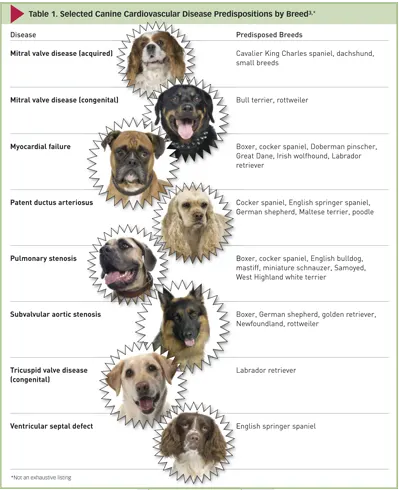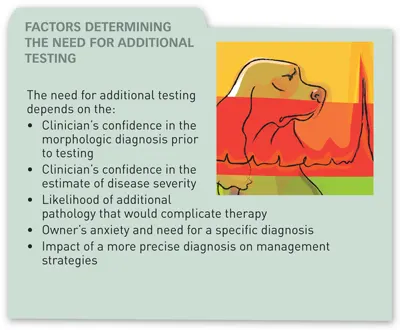Canine Heart Murmur

You have asked…
Some of my canine patients have a murmur but appear otherwise healthy. What should I do?
The expert says…
Murmurs are often indicative of cardiac disease, but many canine patients with murmurs appear healthy. Owners might not recognize a potential problem until a clinician confirms the presence of a murmur and often become anxious because they associate heart disease with substantial morbidity and mortality in humans.
Illustration by Bill Celander
INNOCENT OR NOT?
While cats often have innocent or physiologic murmurs, such murmurs are relatively uncommon in adult dogs.
Puppies, however, often have innocent murmurs; these are soft, blowing, protosystolic (occurring in early systole), left-sided murmurs that generally subside by 12 weeks of age. Obvious or loud murmurs or murmurs auscultated on the right side of the chest should not be considered physiologic in puppies.
Virtually all murmurs in adult dogs are indicative of structural heart disease.
Virtually all murmurs in adult dogs are indicative of structural heart disease.
INITIAL DIAGNOSIS
The cause of a murmur can often be determined or strongly suspected based on auscultation (ie, location, timing, intensity, and quality).
►Virtually all murmurs auscultated in dogs are systolic. ►Right-sided murmurs are caused by either tricuspid regurgitation or ventricular septal defect (VSD). ►Left-sided murmurs are most often caused by myxomatous mitral valve disease (MMVD), stenoses of aortic or pulmonary valves, or patent ductus arteriosus (PDA). These can be distinguished by point of maximal intensity (apical, basilar, or axillary). ►Congenital lesions are much more likely in juveniles; acquired lesions are more likely in adult dogs. ►Mitral regurgitation accounts for most acquired murmurs in canine adults. ►Soft murmurs are generally associated with less severe lesions (either stenotic or regurgitant); loud murmurs can be heard in both mild and severe heart disease. ►Myocardial failure (dilated cardiomyopathy [DCM]) can cause soft murmurs; therefore, a soft murmur in large-breed and dogs predisposed to DCM should alert the clinician to the possibility of DCM.
Congenital lesions are much more likely in juveniles; acquired lesions are more likely in adult dogs.
Heart rate and rhythm can provide clues about severity; sinus arrhythmia (SA) indicates vagal dominance and often less severe disease. However, lack of SA or presence of sinus tachycardia does not necessarily indicate more severe disease but might simply reflect patient stress.
Breed predispositions can help prioritize the list of diagnostic differentials for particular patients (Table 1).
MORE ON WEB:
Read Comparative Imaging: Myxomatous Valve Disease (May 2006) for more information on imaging diagnostics for MVD in dogs. Available at cliniciansbrief.com/journal.
CHF = congestive heart failure, DCM = dilated cardiomyopathy, MMVD = myxomatous mitral valve disease, NT-proBNP = N-terminal pro–B-type natriuretic peptide, PDA = patent ductus arteriosus, SA = sinus arrhythmia, VSD = ventricular septal defect
ADDITIONAL DIAGNOSTIC TESTING
In some cases, sufficient information can be obtained from the physical examination to advise the client without the need to conduct additional testing (see Factors Determining the Need for Additional Testing).
Diseases with left-sided volume overload physiology (PDA, VSD, MMVD) often display characteristic radiographic findings that aid in diagnosis and offer insight into disease severity. Thoracic radiographs sometimes provide all the information required to advise a client, especially in patients with MMVD.
Generally, puppies and juvenile patients with nonphysiologic murmurs should undergo echocardiographic evaluation:
►To help determine the cause of the murmur and severity of underlying disease. ►To allow time for corrective intervention (eg, PDA occlusion or ligation; pulmonary valvuloplasty for pulmonary stenosis) or to inform the owner about likely disease progression. ►To provide additional information on patients with acquired heart disease, especially when myocardial disease (DCM, hypertrophic cardiomyopathy, restrictive cardiomyopathy) is suspected.
Electrocardiography is not generally indicated in murmur evaluation.
Biomarker assays can offer prognostic information to clinicians in the evaluation of patients with subclinical murmurs (dogs with higher NT-proBNP concentrations tend to develop congestive heart failure [CHF] sooner and have a worse survival),1,2 but when further investigation cannot be completed, they should be avoided so as not to confuse the clinical picture.

Lack of sinus arrhythmia or presence of sinus tachycardia might simply reflect patient stress.
MANAGEMENT
Educating clients about the underlying disease process, natural history, and disease severity allows the clinician to alleviate anxiety in many clients or to offer clinical solutions.
Some congenital subclinical heart diseases warrant surgical repair (eg, PDA, pulmonary stenosis), while others might require specific medical therapy (eg, beta blockade for subaortic stenosis). In these cases, a precise diagnosis is mandatory.
Some acquired heart disease also warrants intervention (eg, patients with taurine-deficient myocardial failure should be supplemented with taurine).
Treatment of some causes of subclinical murmurs is unsubstantiated.
►Most dogs (70%) with mild MMVD will never develop CHF. In these dogs, the condition can be considered benign and treatment will not alter clinical outcome.4 ►Dogs with more advanced subclinical MMVD have been shown not to benefit from early intervention with angiotensin-converting enzyme (ACE) inhibitors; progression to CHF is similar regardless of whether patients are treated.5-7 One study claimed benefits of spironolactone therapy in subclinical MMVD, but the study results are questionable and need to be validated by additional studies.8 The effects of pimobendan or beta blockers on progression to CHF are currently being investigated. Clients should understand that the treatments used for subclinical heart disease in humans are not indicated in canine disease.

Early treatment of DCM has not been demonstrated to be beneficial in either preventing or delaying disease progression. One retrospective study suggested mild benefits with enalapril therapy, but prospective studies are required to support this claim.9
When subclinical heart disease is likely to progress to CHF in a foreseeable time frame, the client can be instructed to measure and log the pet’s sleeping respiratory rate (SRR).
►When SRR is higher than 30 breaths/min, the client should present the dog for examination and potential institution of CHF therapy. ►Measuring SRR provides clients with a positive activity that can counteract feelings of helplessness or frustration.
ACE = angiotensin-converting enzyme, CHF = congestive heart failure, DCM = dilated cardiomyopathy, MMVD = myxomatous mitral valve disease, PDA = patent ductus arteriosus, SRR = sleeping respiratory rate